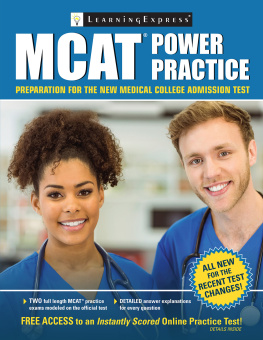CONTENTS INTRODUCTION Math Practice Medication Order Entry and Fill Process Medication Safety PharmacologyDosage Forms PharmacologyDrug Classes PharmacologyGeneral PharmacologyRoutes of Administration PharmacologyTop 200 Drugs Pharmacy Billing and Reimbursement Pharmacy Inventory Management Pharmacy Law and Regulations Pharmacy Quality Assurance Sterile and Nonsterile Compounding Copyright 2014 Learning Express, LLC. All rights reserved under International and Pan American Copyright Conventions. Published in the United States by LearningExpress, LLC, New York. Cataloging-in-Publication Data is on file with the Library of Congress. Printed in the United States of America 9 8 7 6 5 4 3 2 1 First Edition ISBN 978-1-57685-960-5 For information on LearningExpress, other LearningExpress products, or bulk sales, please write to us at: 80 Broad Street 4th Floor New York, NY 10004 Or visit us at: www.learningexpressllc.com Introduction Pharmacy technicians are vital components of the healthcare team. They can work in a variety of settings, including hospitals, retail pharmacies, long-term care facilities, home healthcare and infusion pharmacies, and even nuclear and compounding pharmacies.
Each setting offers a chance for a pharmacy technician to demonstrate different levels of abilities and knowledge. Regardless of the location, most states require pharmacy technicians to be certified. This book can help prepare you for the Pharmacy Technician Certification Exam (PTCE). About the Pharmacy Technician Certification Exam The PTCE is offered by the Pharmacy Technician Certification Board (PTCB) and is a nationally accredited exam. Applicants who pass the exam are then designated as certified pharmacy technicians (CPhT). The certification must be renewed every two years, and 20 hours of continuing education is required for renewal, with at least one of those hours being in the subject of pharmacy law.
The exam is comprised of 90 multiple-choice questions, 10 of which are questions that will not be scored and are placed randomly throughout the exam. These questions will not affect your score. The time allotted to complete the exam is one hour and fifty minutes, and the test is administered on a computer. The PTCE has recently been updated after a job analysis study, with nine new knowledge domains that are organized to better assess technician competencies. The following table lists the new knowledge domains and shows the percentage of content of the PTCE devoted to each section. 
About the Exam for the Certification of Pharmacy Technicians The ExCPT is a nationally accredited exam offered by the National Healthcareer Association.
Applicants who pass the exam are designated as certified pharmacy technicians (CPhT). This certification must be renewed every two years, and during this period the CPhT must complete at least 20 hours of continuing education, including at least one hour of Pharmacy Law. The exam is taken on a computer and contains 110 questions, 10 of which are pre-test questions that will not be scored. You will have two hours to complete the test. The questions that are scored cover three general knowledge areas: 
About the Book This book contains more than 600 concepts, terms, math equations, and skills to help prepare you for the PTCE. It is divided into sections that follow the new layout of the PTCE for easy studying.
The top 200 drugs are included in easy-to-study chart format for easy learning, and sample math problems are included for extra practice. This book should not be memorized in one sitting! Instead, set aside time each day to review and practice terms. Quiz yourself periodically, and move forward from concepts when you have mastered them. Keep a positive attitude, and stay focused. Becoming a certified pharmacy technician is not easy, but the end result is worth the hard work. .......... ............ ............
Household System .......... .......... ............ Common metric conversions encountered for weight and volume: Weight:
Kilogram = kg
Gram = g
Milligram = mg
Microgram = mcg Each row represents an equivalent weight (e.g., 1 kg = 1,000 g)  Volume:
Volume:
Liter = L
Milliliter = mL Each row represents an equivalent volume (e.g., 1 L = 1,000 mL) 
.......... .......... ............
Common household conversions encountered for volume and weight: Volume:
Tablespoon = T
Teaspoon = tsp Each row represents an equivalent volume (e.g., 1 gallon = 128 fl oz) 
Each row represents an equivalent weight 
.......... .......... ............ Apothecary system .......... .......... ............
Conversions Between and Within Measurement Systems .......... .......... ............ The apothecary system is an older, less frequently used, system of measurement. The most common units in this system are: 
.......... ............ 
When converting between metric units align your units from biggest to smallest. 
When you move from a unit that is bigger (kg) to smaller (g), you will always move the decimal point to the right. 
When you move from a unit that is bigger (kg) to smaller (g), you will always move the decimal point to the right.
When you move from a unit that is smaller (g) to bigger (kg), you will move the decimal point to the left. In the chart above, each unit is separated by three decimal places. To convert from kg to g, move the decimal point to the right three places. To convert from mcg to g, move the decimal point to the left six places. Example: Convert 5 kg into mg: Look at the chartmg is 2 blocks to the right of kg, which means we will move our decimal point 6 places to the right: 5 kg = 5,000,000 mg. .......... ............ ............
Roman Numerals .......... .......... ............ Military Time .......... ..........  Three main rules for Roman numerals: 1.
Three main rules for Roman numerals: 1.  Three main rules for Roman numerals: 1.
Three main rules for Roman numerals: 1.
A letter repeated once or twice is added that many times, but never more than 3 (XXX = 30, MM = 2,000). 2. When a letter placed after another letter is smaller than the previous letter, the two are added together (VII = 7, XI = 11, LV = 55). 3. When a letter placed before another letter is smaller than the following letter, the value of the first letter is subtracted from the value of the second letter (IV = 4, IX = 9, XL = 40). .......... ............ ............
Next page


















 Volume:
Volume:





 Three main rules for Roman numerals: 1.
Three main rules for Roman numerals: 1.